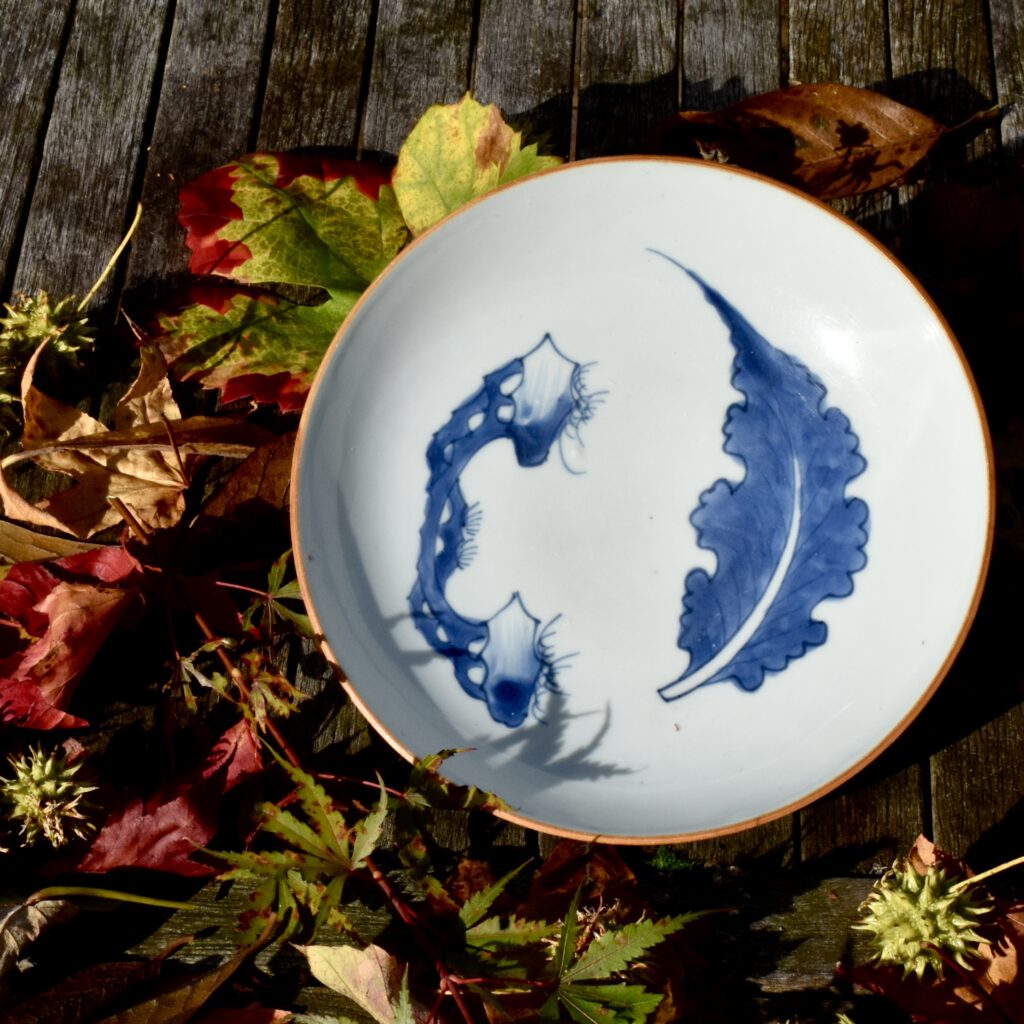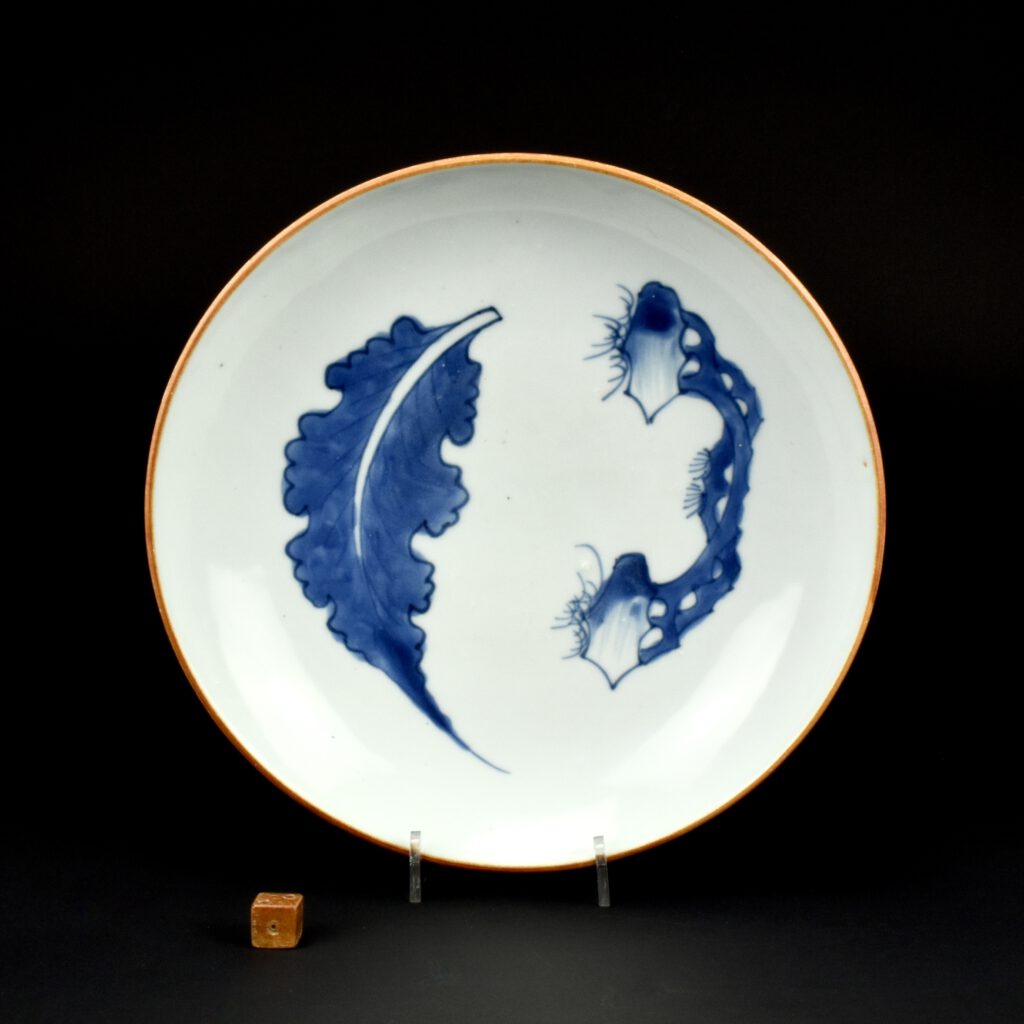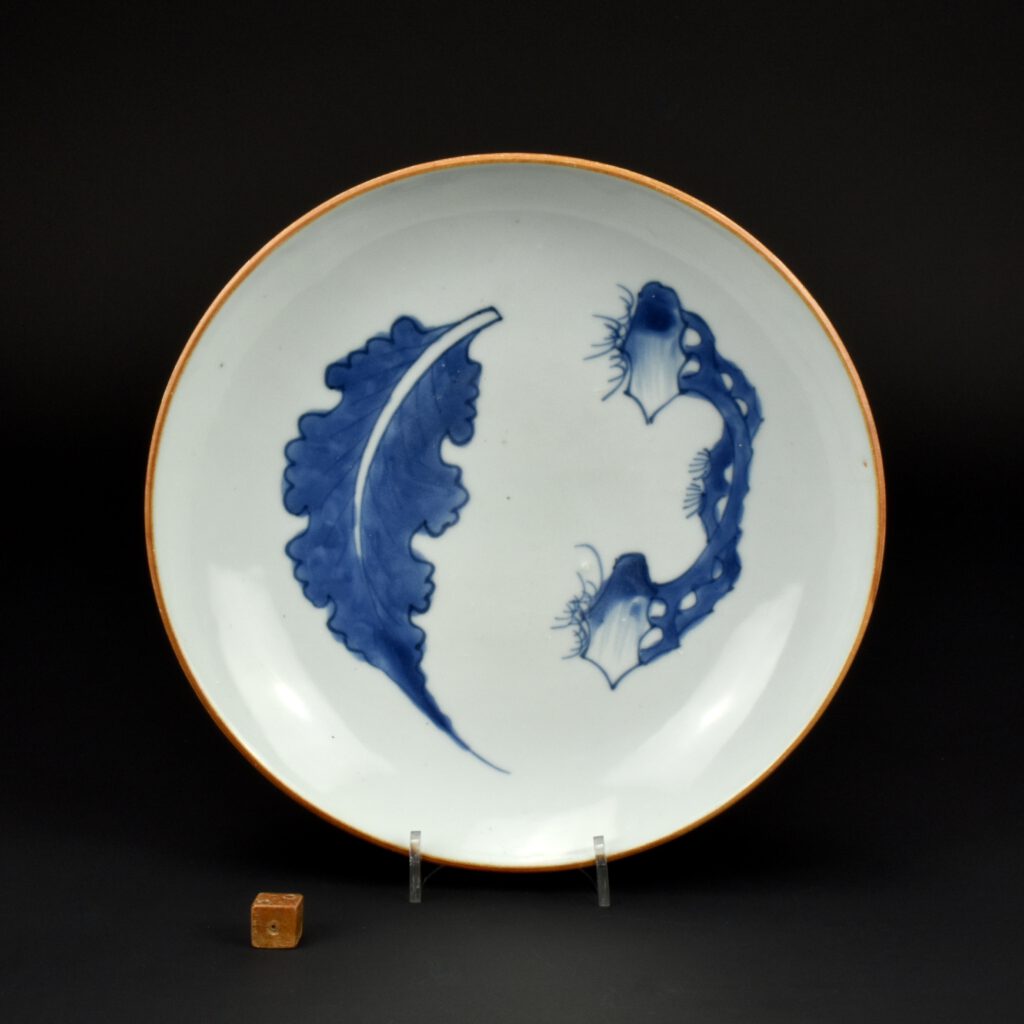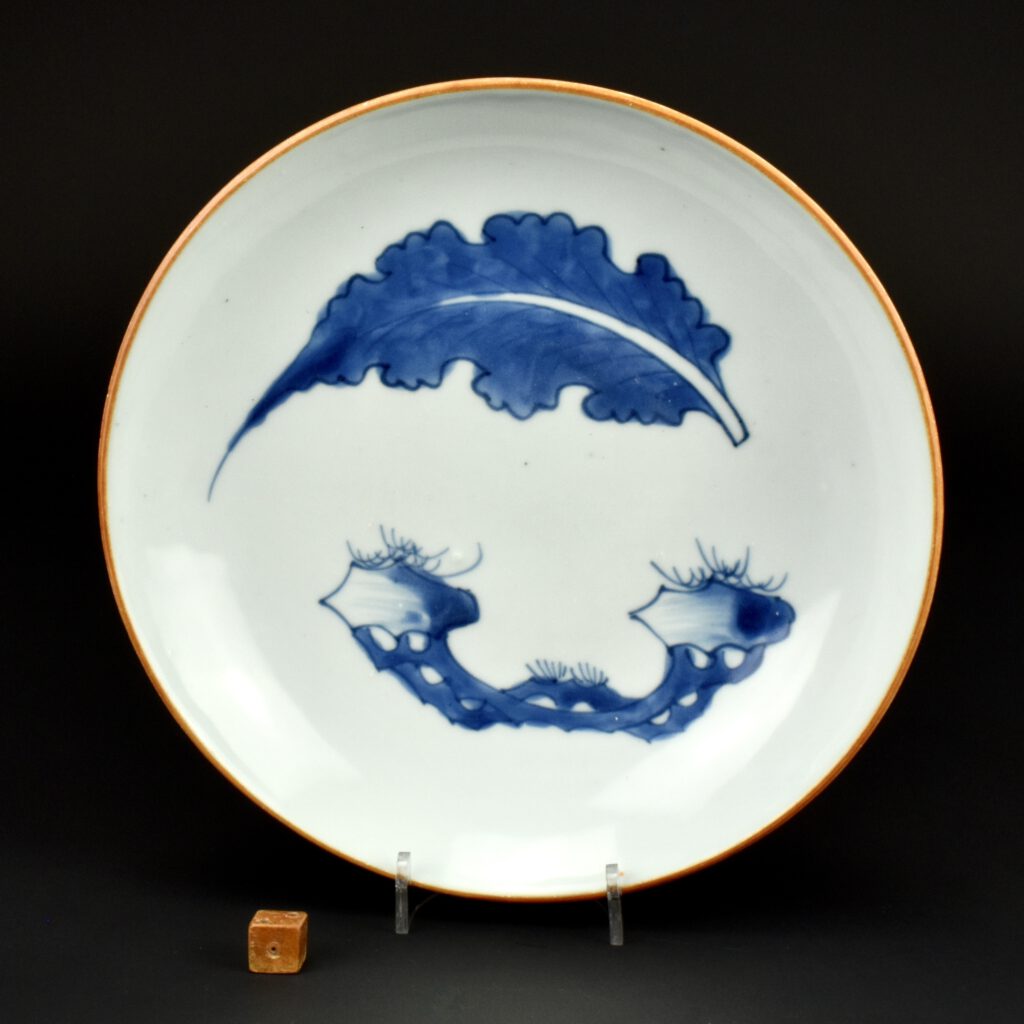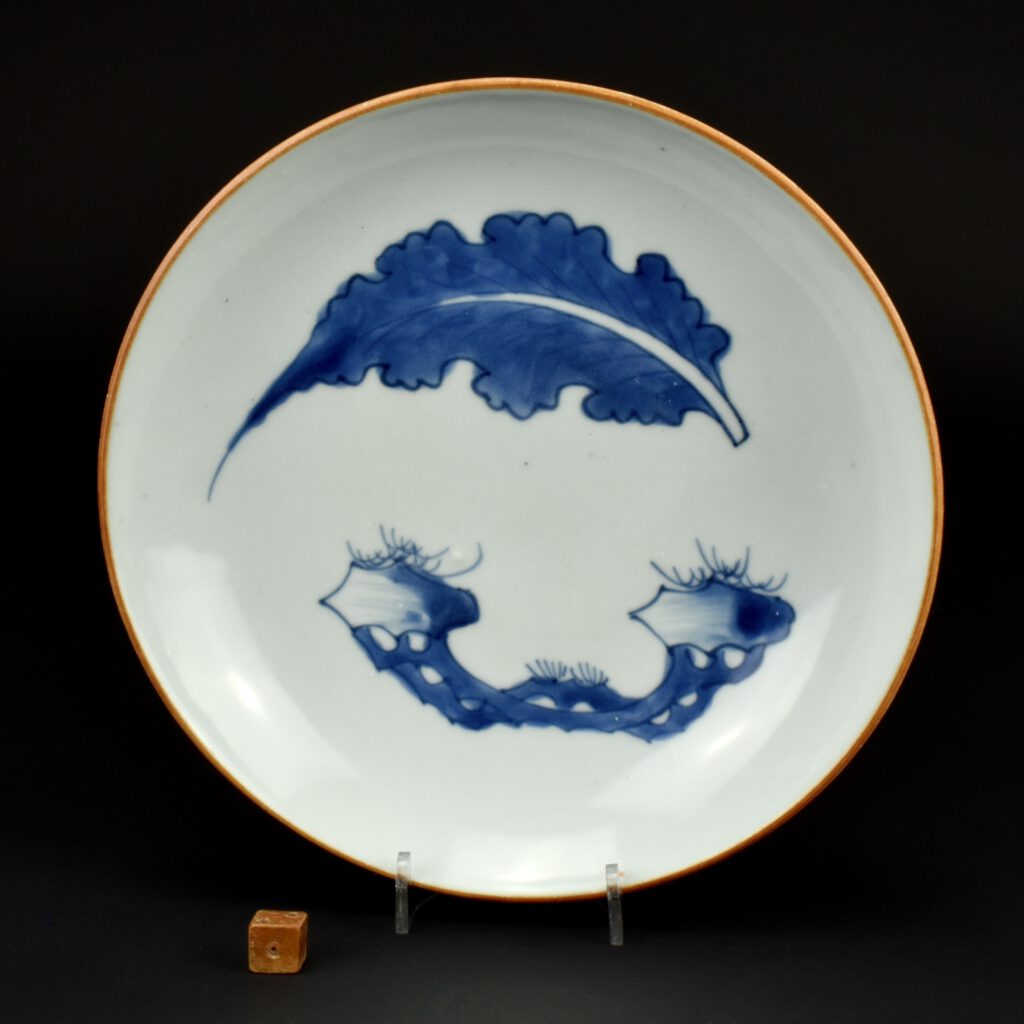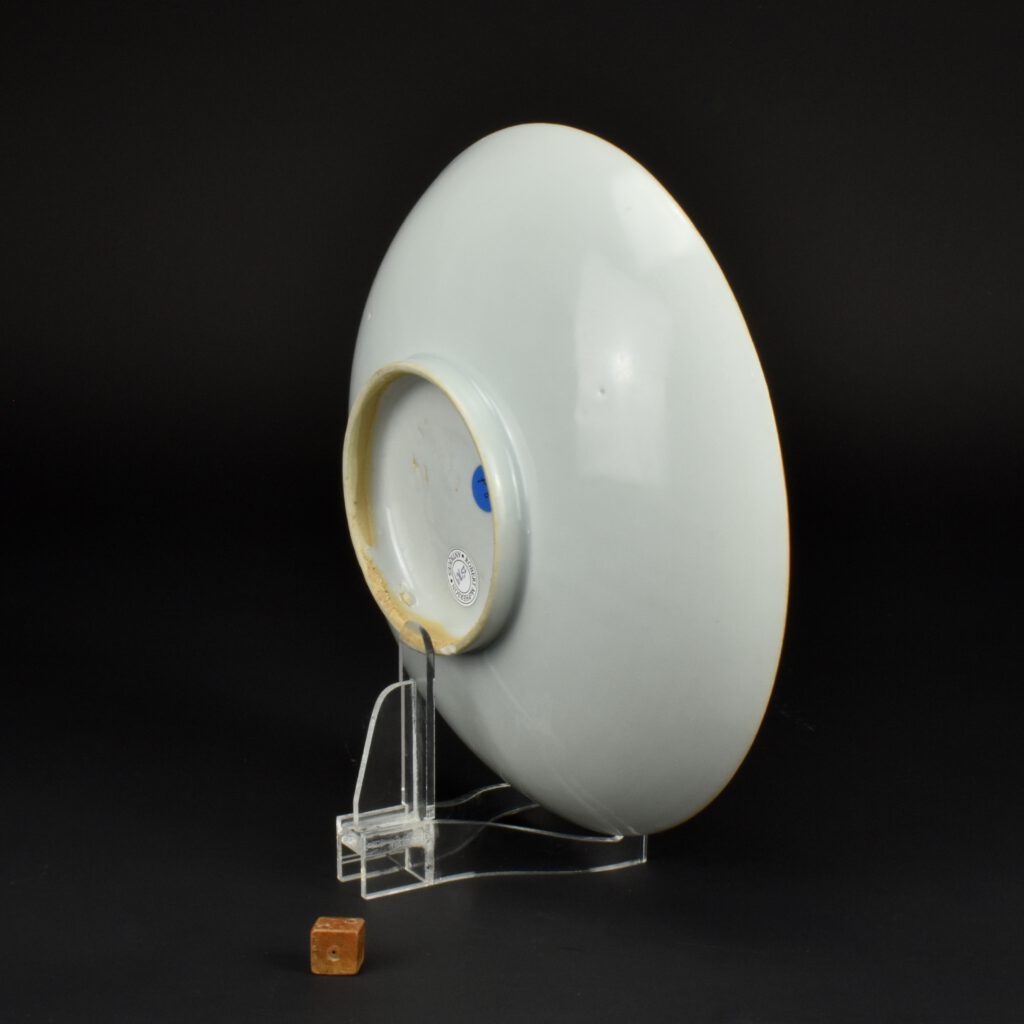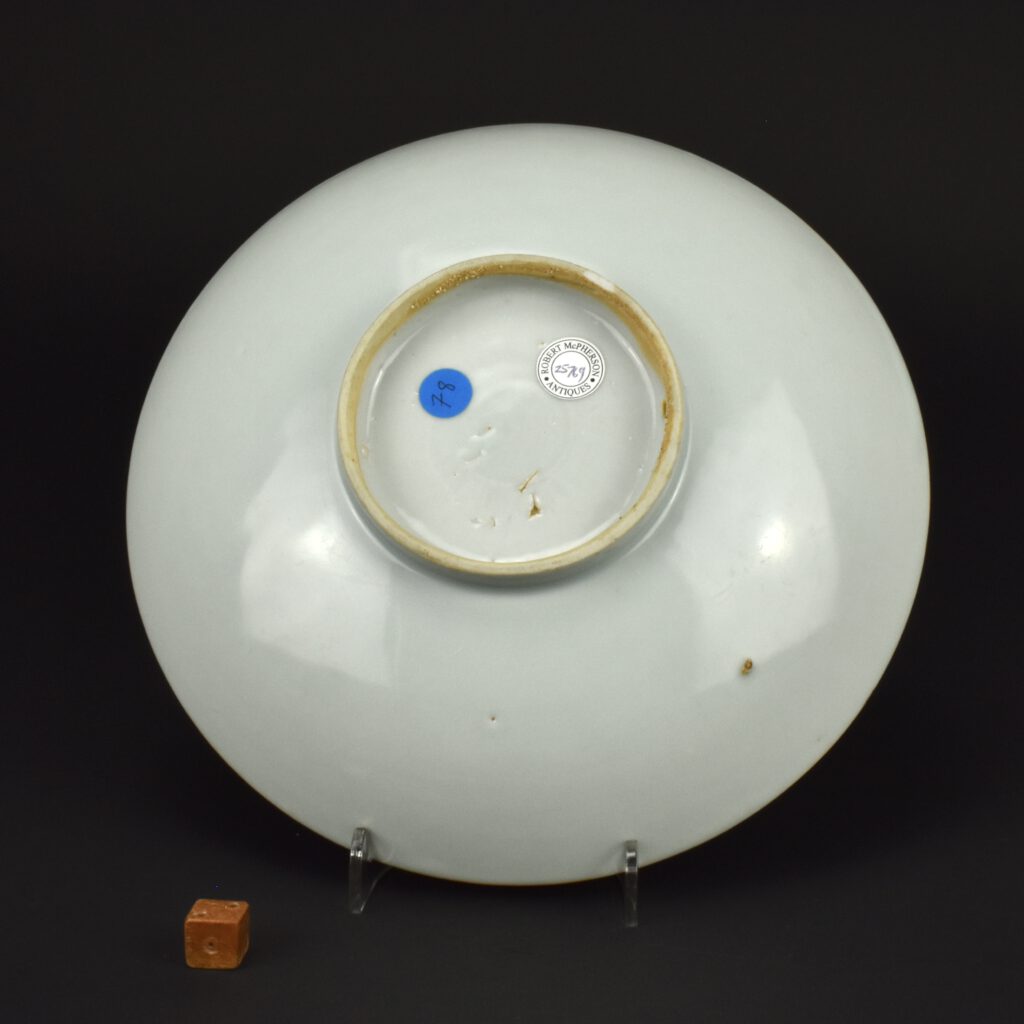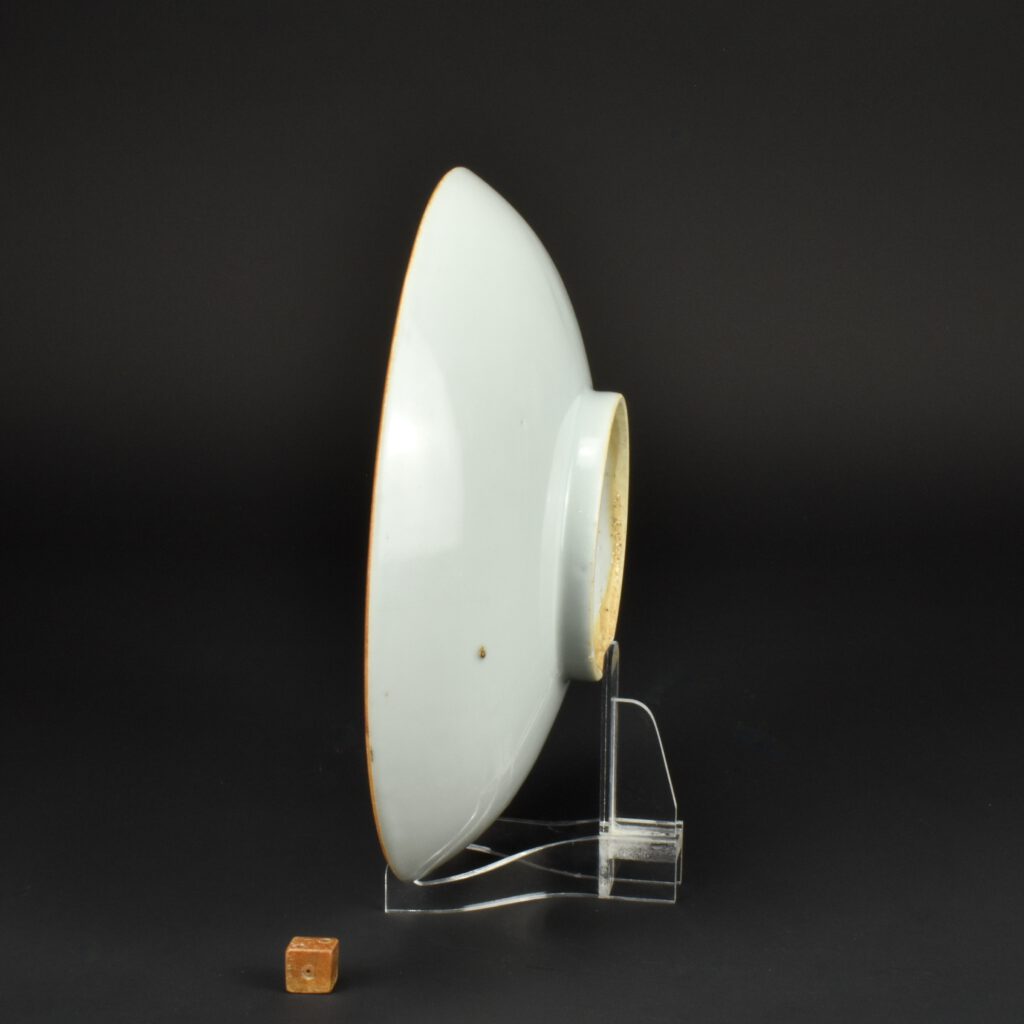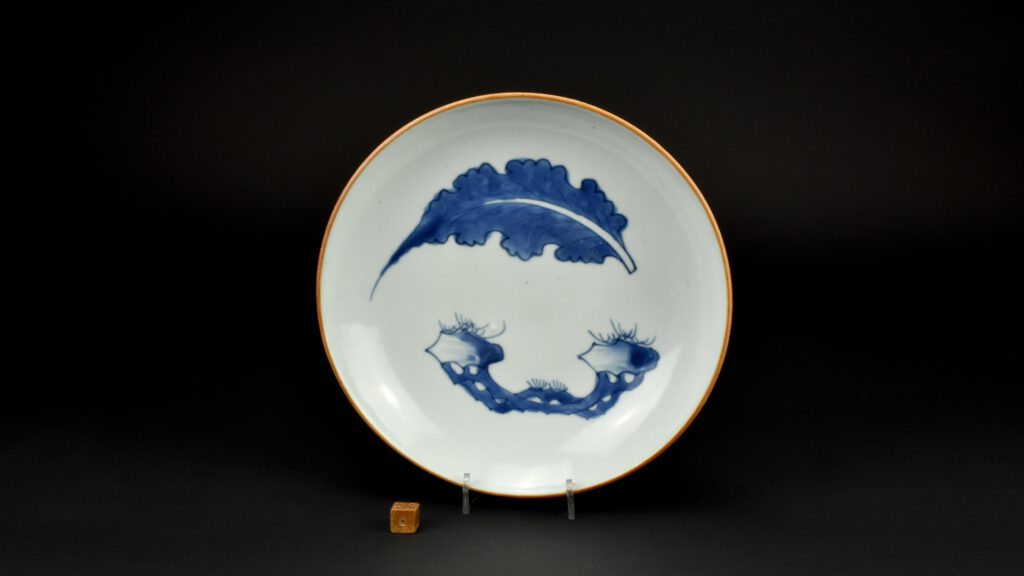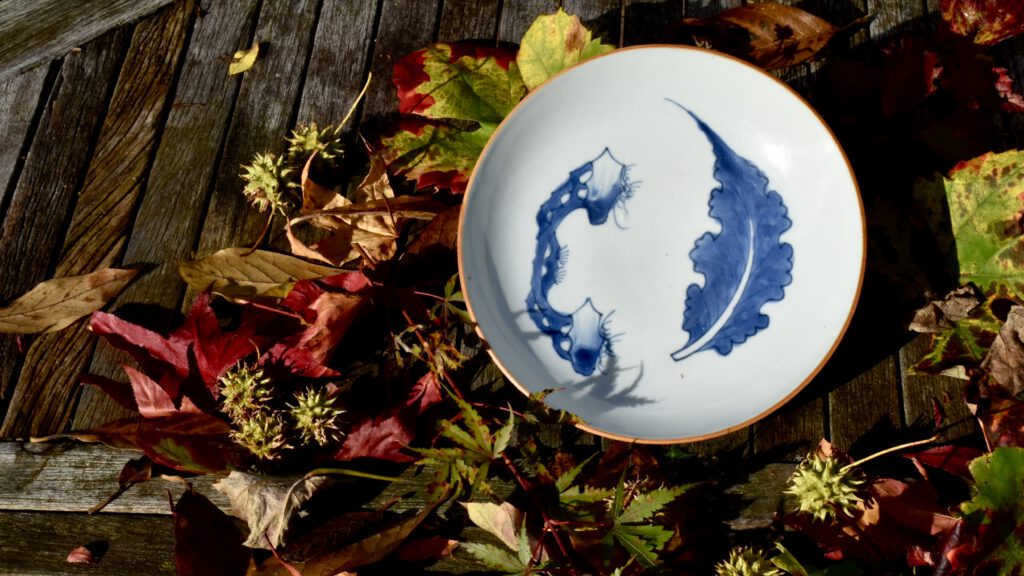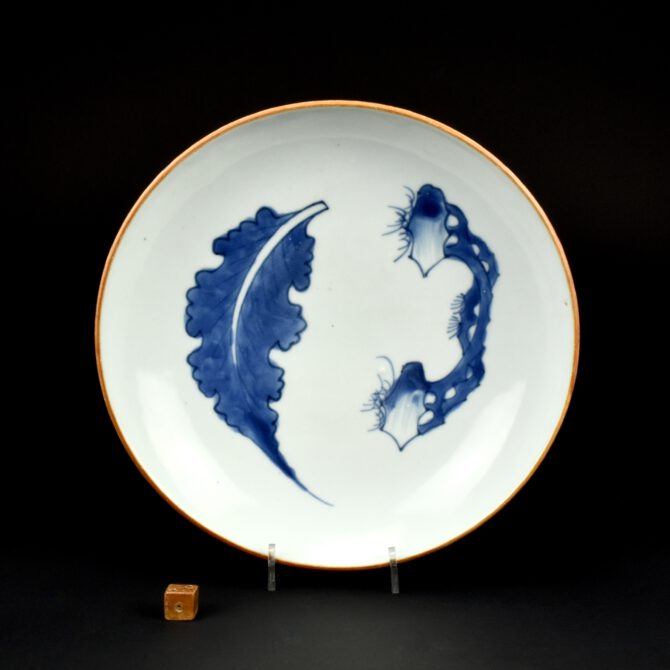
A Blue and White Transitional Porcelain Leaf and Rock Dish, Shunzhi Period
A 17th Century Chinese Blue and White Porcelain Saucer Shaped Dish, Shunzhi Period 1644 – 1661, Jingdezhen Kilns. Dishes of this type, painted with a leaf next to a taihu rock were made during the reign of Shunzhi (1644-1661), with variations carrying on until the early Kangxi period c.1662 to 1670. See below for a Kangxi dish we sold some years ago that came from Marchant & Son, which is dated 1667. A number of these later smaller dishes are known, another dated 1667 is in the Butler Collection (see references). The present example is closer to, but not the same as the two from the Butler Collection, dated to Shuzhi (see references). A considerable numbers of these dishes are in the Palace Museum in Beijing, suggesting they were made for the domestic market, an early example is in the Palace Museum examples, dated to 1648. Indeed, they do not seem to appear in early European collections. The leaves vary from dish to dish, clearly representing different tree species. A second example, in the Butler Collection (III.3.35), specifically mentions a Wutong leaf (firmiana simplex) in the poem. The inscribed poems on these dishes were done by using a wax resist technique. The cobalt pigment would not adhere to the wax characters, it would be burnt off during the firing after glazing leave the white characters we see today. Dishes of this type with designs with poems and symbolism must have appealed to the Scholar class in China. As with other Shuzhi porcelain of this type the glaze has a distinct blue green tinge.
See Below For More Photographs and Information.
SOLD
- Condition
- There is a feint hairline crack to the rim.
- Size
- Diameter 20.6 cm (8.1 inches). Depth 5 cm (2 inches).
- Provenance
- N/A
- Stock number
- 25769
Information
Leaf and Poem Dishes From Robert McPherson Antiques.
A Related, But Later Dated Transitional Dish, Early Kangxi Period 1667.
R & G McPHERSON ANTIQUES ‘SUMMER EXHIBITION’
Including Chinese and Japanese Ceramics from The John Drew Collection Part II.
KANGXI 1667
A Rare Dated Early Kangxi Blue and White Porcelain Dish in the Chinese Taste, 1667.
The base dated 1667, the poem next to the leaf on the front reads ‘When this leaf falls everyone knows the autumn season is coming’.
For a very similar Kangxi blue and white porcelain dish also dated 1667 from the Butler Family Collection (collection number F22) see : Seventeenth Century Jingdezhen Porcelain from the Shanghai Museum and the Butler Collection (Shanghi Museum,2006. ISBN 1-85759-417-7) page 35 fig 6 ; We would like to thank Mr S. Balmer for drawing our attention to this reference.
Provenance :
S.Marchant & Son.
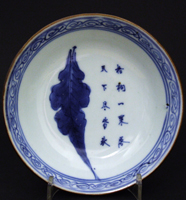
A Similar Cruder Transitional Porcelain Dish
R&G McPherson Antiques
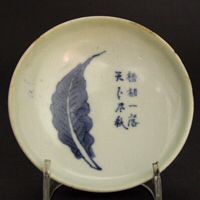
A 17th Century Chinese Blue and White Porcelain Saucer Shaped Dish, Shunzhi or Early Kangxi c.1650 – 1670, Jingdezhen Kilns.
Robert McPherson Antiques - Sold Archive - 25757
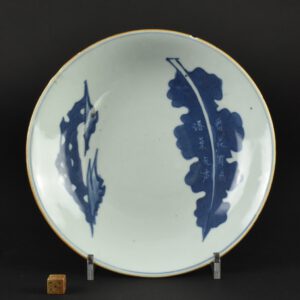
Condition
One small rim chip. Some unevenness to the rim.
Size
Diameter : 19.9 cm (8 inches)
Stock number
25757
References
For two dishes of this type dated to the Shuzhi period (1644-1661) see : Leaping The Dragon Gate, The Sir Michael Butler Collection of Seventeenth Century Chinese Porcelain (Teresa Camepa and Katherine Butler, Ad ILissvm. 2021. ISBN 978-1-912168-16-3) Page 287, III.3.34 and III.3.35. For a similar slightly later version, Kangxi blue and white porcelain dish dated 1667, from the Butler Family Collection (collection number F22) see : Seventeenth Century Jingdezhen Porcelain from the Shanghai Museum and the Butler Collection.
Two Shunzhi Porcelain Leaf and Rock Dishes.
Robert McPherson Antiques - 25769 and 25680A.
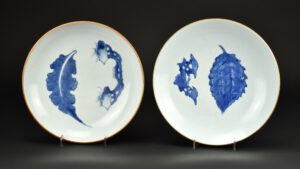
A Rare Japanese Shoki-Imari blue and White Porcelain Leaf and Poem Bowl c.1610-1640.
Robert McPherson Antiques Stock Number 27408.
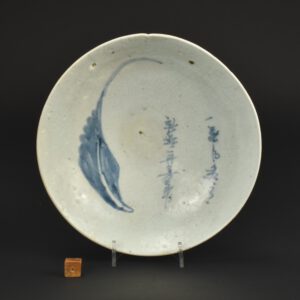
Two Japanese blue and White Porcelain Leaf and Poem Dishes.
17th and 18th Century - Robert McPherson Antiques.
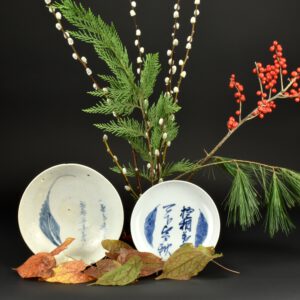
A Small Blue and White Japanese Porcelain Poem and Leaf Dish, Arita Kilns c.1690 - 1730. This thickly potted dish has a poem written in a quickly drawn cursive script, the poem is flanked by two leaves. The reverse painted with Karakusa scrolling foliage and a type of Fuku mark. This design is based on earlier Chinese and Japanese porcelain from the 17th century.
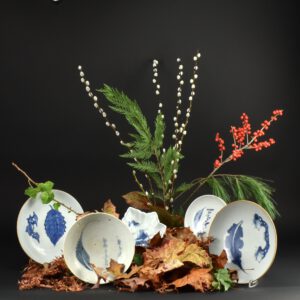
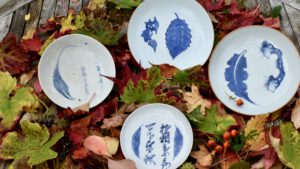
Scholars Rocks :
Chinese scholars` rocks, also known as scholar stones or viewing stones, are small shaped or naturally-occurring rocks appreciated by Chinese scholars from the Song dynasty onwards, and quite frequently found in traditional Chinese gardens.
The most highly regarded stones are lingbi rocks, from Lingbi County of Anhui Province, with the finest examples dating from the Ming dynasty and Song dynasty.
Taihu rocks are also prized, and are commonly used as garden stones. They influenced the development of Korean stone art and Japanese suiseki aesthetics and styles and were an important part of Confucian art. Natural stone and rock formations, with no artificial carvings, are preferred. Rocks would sometimes be carved and then thrown back into a lake so that any markings could be washed away. Scholars rocks can be any colour, and contrasting colours are not uncommon. Sometimes they feature painted patterns, which can be of any subject, either natural or abstract. The size of the stone can also be quite varied: scholars rocks can weigh either hundreds of pounds or less that one pound. Subtlety of colour, shape, and markings is also desired, as is beauty of texture and shape. Scholars stones are usually reminiscent of someone or something, or it may convey a spiritual nature that moves viewers in some way. They are usually set upon a stable surface, such as a rosewood pedestal that has been carved specifically for the stone.
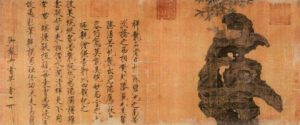
LEAPING THE DRAGON GATE
THE SIR MICHAEL BUTLER COLLECTION OF 17th-CENTURY CHINESE PORCELAIN.
Teresa Canepa and Katharine Butler
Available Directly from https://butlercollection.com/the-book/
Hardback £ 175 / €200.
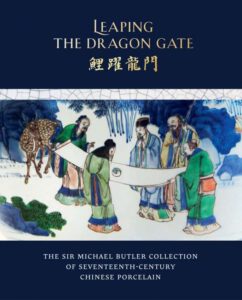
It is the history of 17th-century Chinese porcelain told and illustrated by his comprehensive collection and includes a vast amount of new research into the iconography, production dates and markets of the porcelain. In 576 pages, it includes the story of how the collection was made, a chronological study of the porcelain as well as maps and tables showing the kiln sites, important shipwrecks and all known dated porcelain from the period. With over 1000 illustrations, it is a worth testimony to Sir Michael’s incredible depth of knowledge and his contribution to research in this field.
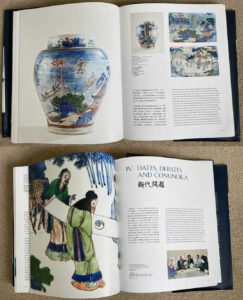
BOOK REVIEWS
“magisterial and scholarly… ….one must salute the range, breadth, and aspiration of the book, which will surely stand as a standard reference work for years to come, as well as a recognition of one man’s contribution to the field.”—Orientations
“Over the course of 50 years, the keen-eyed diplomat Michael Butler built up the largest collection of 17th-century Chinese porcelain in the world.” —Apollo
“The book brings a wealth of new research … and by comparison to a huge database of dated porcelains assembled and published in the book.” —Asian Art Newspaper
“This handsome volume has been a monumental undertaking….and fulfils two distinct purposes. It is at once a tribute to Sir Michael Butler while also providing a very scholarly catalogue raisonné of his collection… Beautifully produced, lavishly illustrated….fully bilingual” – Arts of Asia
“this new bilingual book…adds another dimension to the existing literature. It provides both a systematic study of the collection and places it within a framework of existing seventeenth century pieces around the world…. A wonderful reference work for ceramic enthusiasts” – The Oriental Ceramics Society Newsletter
“Books such as this provide a firm, scholarly basis for our future understanding of this specialist field
of ceramic history, affirming the place of the Butler Collection in the global history of collecting Chinese ceramics.” The Burlington Magazine
“This is a landmark for the field and an extraordinary tribute to (Sir Michael’s) work” Mike Hearn, Douglas Dillon Chairman, Dept. of Asian Art, Metropolitan Museum, New York
“a fitting memorial……remarkable….this is the place to learn the meaning of the …subjects and stories painted on porcelain” —Country Life
The Transitional Period c.1620 - 1680.
The roots of this unsettled period starts during the later part of Wanli`s reign (1573-1620). At the begging of his reign China was doing very well, new crops from the Americas such as peanuts, maize and sweet potatoes increased food production, while simplified taxes helped the state run smoothly. But this was not due to Wanli`s enlightened reign, but to his Mother championing a man that was to become the Ming dynasties most able minister, Zhang Zhuzheng (1525—1583). Wanli became resentful of Zhuzheng`s control but upon his death became withdrawn from court life. Between 1589 to 1615 he didn`t appear at imperial audiences, leaving a power vacuum that was filled by squabbling ministers. Mongols from the North raided as Japan invaded Korea. Wanli re-opened the silver mines and imposed new taxes but the money was lost due to corruption, as well as being frittered away by the indulgent Emperor himself . The next emperor of Ming China, Tianqi (1621-1627), was bought up in this self indulgent disorganised environment, at the very young age 15 his short reign started. He didn`t stand a chance. Tianqi made the mistake of entrusting eunuch Wei Zhongxian (1568-1627) who Anna Paludan in her excellent book “Chronicle of the Chinese Emperors” (Thames and Hudson, 1998) describes as “a gangster of the first order”. Tianqi was deemed to have lost the Mandate of heaven by the Ming people. Tianqi`s younger brother, the last of the Ming Emperors, Chongzhen (1628-1644), was not able to save the situation. The systems of administration had broken down, corruption was rife and so when a sever famine broke out in 1628 nothing much could be done. Anna Paludan describes the tragic end to the great Ming Dynasty “The final drama was worthy of a Greek tragedy. The emperor called a last council in which `all were silent and many wept`, the imperial troops fled or surrendered, and the emperor, after helping his two sons escape in disguise, got drunk and rushed through the palace ordering the women to kill themselves. The empress and Tianqi`s widow committed suicide; the emperor hacked off the arm of one daughter before killing her sister and the concubines. At dawn he laid his dragon robe aside and dressed in purple and yellow, with one foot bare, climbed the hill behind the now silent palace and hanged himself on a locust tree”. The Great Wall of China, started 2,000 years ago was built to protect China from the Northern barbarian hoards, it was often tested and sometimes failed. The Jin people invaded China, ruling the North between 1115 and 1234, it was their descendants the Manchus, Jurchens from south east Manchuria that took full advantage of the problems of the Ming dynasty. In 1636 they adopted a Chinese dynastic name, the `Great Qing` (Qing meaning pure). The first of the Qing emperors was Shunzhi (1644-1661) but for most of his reign his uncle ran the state. War raged on during this period and it wasn`t until the second Qing emperor Kangxi (1662-1722) that true peace was achieved. Kangxi was a wise and educated man, he became a highly successful emperor bringing China a long period of wealth and stability.
